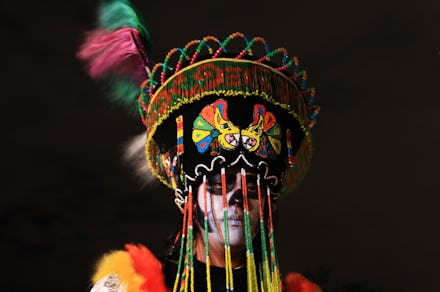This is What "Halloween" Looks Like in 5 Countries Around the World

Death, considered a taboo topic for some cultures, is relished and celebrated by others. For Americans, Halloween has more to do with over-indulgence and obsession with candy, costumes, and haunted houses than it does the reverence of the dead (zombies excluded). However, that's not the case everywhere. From Mexico’s Día de los Muertos to Japan’s Obon, these five celebrations from around the world contain a whole lot less candy than Halloween, but much more rich and unique culture.
1. Guédé
Where: Haiti
When: November 2
Guédé means “guardian of the dead” and refers to a prominent Voodoo spirit. Celebrated alongside the Catholic All Souls’ Day, Guédé is revered by almost all Haitians, from Catholics to those who practice Voodoo. This holiday serves up numerous methods of celebration from attending church to praying for those who have passed, to spreading white chalk on your face while filling your mug to the brim with rum. Although the holiday celebrates ideas that have existed for centuries, the holiday will be marking its’ 10th year since its celebration was was made legal in 2003 by the government. The holiday has its philanthropic principles, where the poor are served before anyone else. People also keep their eyes peeled for the return of the dead, known as Guédé’s return.
2. El Día de los Muertos
Where: Mexico (also prominent throughout Latin America)
When: October 31 — November 2
El Día de los Muertos (Day of the Dead) may start on the same day as Halloween, however, indigenous traditions are deeply embedded in the Mexican holiday, which has roots dating as far back as the Aztecs, who dedicated the day to the goddess of the underworld, Mictecacihuatl. Observers of the holiday celebrate by constructing altars known as ofrendas, and decorating them with religious symbols, candles, flowers, and photos of deceased relatives. After praying, remembering the deceased, and offering food to the spirits, the living eat the favorite dishes of the deceased and sing, dance, and tell stories of their loved ones. The holiday continues to thrive in Mexico, Brazil, and Spain.
3. Chuseok
Where: North and South Korea
When: 15th day of the 8th Lunar month (middle of autumn)
Few things come to mind when we think of what North and South Korea share, byond of the perilous border between the two countries. But not even bitter relations can diminish the importance of this holiday. Chuseok has become such an integral tradition in Korea that both nations continue to celebrate in similar ways. The three-day holiday celebrates the harvest. The celebration is observed by extended family members of the deceased who visit ancestral hometowns and host a feast filled with traditional Korean food. There are three duties associated with Chuseok three duties: bulcho, sungmyo, and charye. Bulcho is the cleansing of the graves and the area surrounding the graves of all family members. Sungmyo is the payment of respect to the grave by bowing and serving delicacies. Finally, charye is a strict setting of the food before the ancestors at home. The North Korean version of Chuseok has seen an absence of most festivities, as the poor do not have the means to visit graves or serve offerings.
4. Pchum Ben
Where: Cambodia
When: 10th Khmer Month (normally September — October)
Pchum Ben roughly translates to All Souls’ Day, and is a Buddhist holiday. It lasts for 15 days, but the fun kicks in on the last day, when people don their finest clothes, chant, and dedicate food and offerings to the dead as a sign of respect. People of all social classes convene on the pagoda (a tiered tower normally used as a place of worship) and some throw sticky rice in the air as a way to feed their dead ancestors. Regardless of whether the ancestor is in hell or heaven, all spirits benefit from the offerings according to Buddhist doctrine. Pchum Ben has seen strong participation, even among those who aren't religious. Following the brutal Cambodian genocide, during which over one-third of the Cambodian population perished at the hands of Pol Pot’s Khmer Rouge party, PChum Ben is seen as a vital time for Cambodians to maintain relationships with both the dead and living.
5. Obon
Where: Japan
When: July 15 or August 15 (depending on geographic location)
Like Pchum Ben, the Obon festival is a Buddhist holiday, though it is celebrated primarily in Japan. With over 500 years of history under its belt, the festival lasts for three days, and includes cleaning the graves of ancestors and presenting food offerings in front of the Buddhist altar, known as a butsudan. People visit the graves of their loved ones and call for them to come back home. Buddhist beliefs state that during Obon, the ancestors’ spirits return to their relatives. People perform the bon odori, a folk dance, during the nights of Obon while chochin lanterns light the streets.